Introduction
The Enneagram personality test will identify you as one of nine different core types, each with its own personally-unique traits, fears, and motivations. Finding your Enneagram type may help you identify unconscious motivations and patterns and help you gain personal insight into relationships, personal growth, and career paths.
Additionally, each core type is believed to have two neighboring types, one on each side, and these neighboring types are known as wings. While an individual has a dominant core type, they may exhibit some traits or behaviors of their wing types. Wings add additional nuances and variations to an individual's personality, providing a broader understanding of their characteristics.
Some Enneagram advocates claim it dates back thousands of years through the connection of the "eight deadly sins". The connection between the concept of the "eight deadly sins" and the Enneagram test is not directly or explicitly stated in the Enneagram system. The Enneagram focuses on understanding personality types, motivations, and patterns of behavior, while the "eight deadly sins" are moral vices within a religious context. However, the more commonly known Enneagram system came about in the early 20th century.
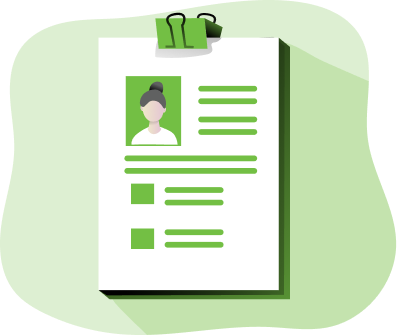
Most accreditation goes to Oscar Ichazo. He was a Bolivian-born philosopher, spiritual teacher, and founder of the Arica School, which integrated elements of psychology, philosophy, and spirituality. He is believed to have developed the modern Enneagram "personality typing" system. Ichazo identified nine personality types, which he believed were based on nine fundamental aspects of human consciousness.
Critics argue that the Enneagram lacks the rigorous testing and validation necessary to be considered scientifically sound. There is limited peer-reviewed research and much of the available literature consists of anecdotal evidence and subjective interpretations.
While some proponents of the Enneagram claim its effectiveness, it is important to approach it with a critical mindset and be aware of its limitations.
The Enneagram can provide insights and be a useful tool for personal growth and self-reflection, but it should not be considered a definitive or scientifically validated measure of personality.
Enneagram advocates say it was designed to help us break free from our habitual patterns by identifying our type and instead becoming more aware of our biases and tendencies.
Key focuses include strengthening relationships, expanding personal insight, navigating conflict, and building deeper connections. The Enneagram is utilized by:
-
Individuals seeking self-awareness
-
Therapists and counselors
-
Leadership and organizational development
-
Spiritual and religious communities
-
Relationship and couples counseling
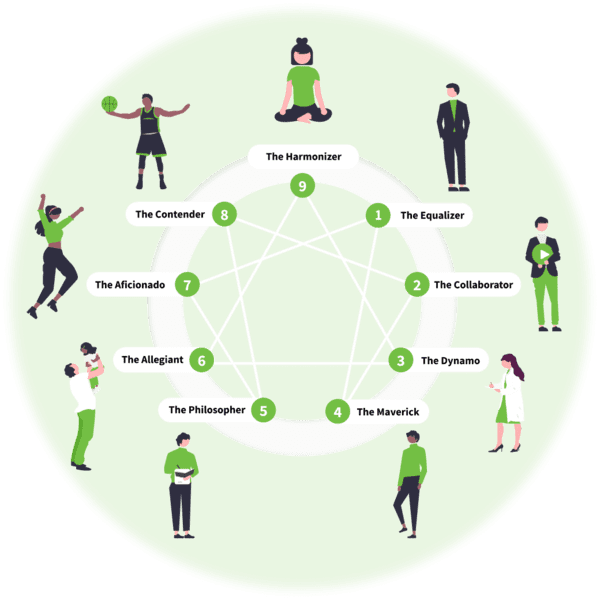
Even though the Enneagram could help us understand and learn how to work with human personalities better, remember not to self-diagnose, and stay open-minded about the results.
How to Take The Enneagram
Taking an Enneagram test and answering honestly is the beginning of the exploration of your dominant Enneagram Personality Type.
For greater accuracy in detailing your personality type, wings, and bounds, it is important to answer the questions as accurately as possible, based on your behavior and motivations rather than how you think you "should" answer or how you "want" to be perceived.
Keep in mind though it may be called a personality "test," "assessment," or "quiz," there is no wrong answer as long as you are answering honestly about yourself.

Example Enneagram Questions
Though the questions may vary depending on where you are taking the Enneagram test, you can expect questions similar to the following:
I have too often focused on:
-
Myself
-
Others
It's been difficult for me to:
-
Stop over-considering alternatives
-
Be more flexible
I have tended to be:
-
Hesitant and procrastinating
-
Bold and domineering
After you take the test, you will see your dominant personality core type, your triad, and the "wings" of your personality.
What is an Enneagram Core Personality Type
Our core type is the dominant personality type that shapes our worldview, emotional responses, and behavior.
What are Triads
The nine Enneagram core types are divided into three categories called triads - the Body Triad, the Heart Triad, and the Mind Triad. They are sometimes referred to as the centers of intelligence or "centers". There are three dominant types within each Triad. Each triad is based on a common driving motivation and describes where the motives may derive from.
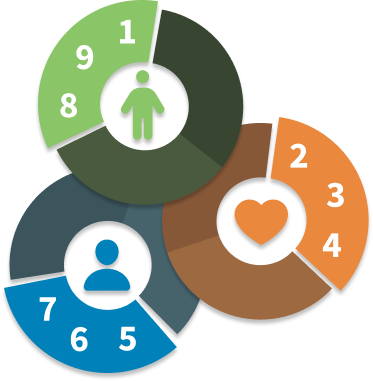
Types 8, 9, and 1 are guided by the Body Triad
Instinctive center
The Instinctive Center primarily deals with how we navigate the physical world through instincts, gut reactions, and the body's responses to the environment.
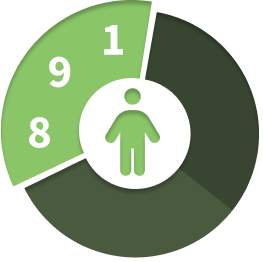
Body Triad
Types 8, 9, and 1 tend to be more grounded in their physical experiences and have an innate focus on self-preservation, control, and maintaining boundaries.
Each type within the Instinctive Center has its own distinct patterns of behavior and motivations related to the instincts of self-protection, aggression/assertion, and adherence to rules or principles.
Understanding the Instinctive Center helps to highlight how individuals maintain personal security and control.
Types 2, 3, and 4 are guided by the Heart Triad
Feeling center
The Heart Triad primarily focuses on emotions, relationships, and interpersonal dynamics.
The Heart Triad consists of Enneagram Types 2, 3, and 4. These types are characterized by their emotional sensitivity, a strong desire for connection and validation, and a tendency to orient themselves around relationships and identity.
Type 2 is driven by a need to be helpful and loved by others. Type 3 is motivated by success and recognition in order to gain love and admiration. Type 4 is oriented towards identity and expressing their unique emotions in search of a sense of specialness.
Understanding the Heart Triad provides insights into how individuals within these types experience and express emotions, seek validation and love, and navigate relationships. They may have different coping strategies and underlying motivations related to their emotions and interpersonal connections.
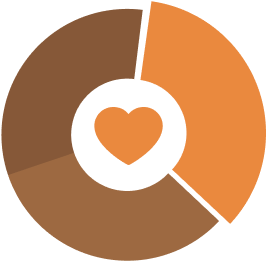
Heart Triad
Types 5, 6, and 7 are guided by the Mind Triad
Thinking center
The Mind Triad primarily focuses on thinking patterns, cognitive processes, and the intellectual approach to the world.
The Mind Triad consists of Enneagram Types 5, 6, and 7. These types are characterized by their relationship with fear, anxiety, and their preferred ways of engaging with information and ideas.

Mind Triad
Type 5 tends to withdraw and seek knowledge as a means of managing fear and gaining a sense of security. Type 6 can display a mixture of anxiety, loyalty, and a desire for safety and guidance from trusted sources. Type 7 often seeks stimulating experiences and distractions to avoid discomfort or painful emotions.
Understanding the Mind Triad sheds light on how individuals within these types process information, manage fears and anxieties, and engage intellectually with the world. They may have distinct ways of seeking security, managing uncertainty, and navigating decision-making processes.
Our wings are the adjacent personality types that may influence your core type. Each core type is believed to have two neighboring types, one on each side, and these neighboring types are known as wings.
Understanding Your Wings
While you have a dominant core type, you may exhibit some traits or behaviors of your wing types. Wings add additional nuances and variations to an individual's personality, providing a broader understanding of characteristics and helping identify some of the more complex aspects of your personality.
Example: Type 9 personality that has a Type 1 and Type 8 wing. While an individual may exhibit more Type 9 traits publicly, they may also exibit traits of both Type 1 and 8 in close relationships, long-term friendships, and families.
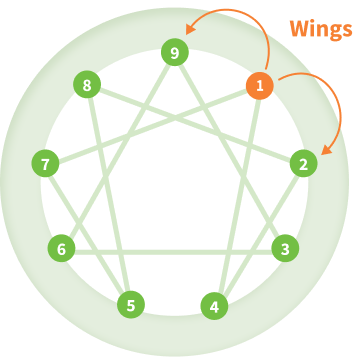
The Enneagram results focus on nine personality types. Different sources of assessments often name the nine types differently. However, the number (1-9) represents the Enneagram type and should be similar in description regardless of the other associated name.
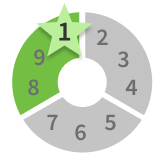

#1. The Equalizer
Type one is the Equalizer. The Equalizer is principled, self-controlled, and highly critical of themselves and others. Ones have a strong sense of right and wrong and strive to live up to their ideals, but may struggle with self-doubt and a tendency toward self-criticism.
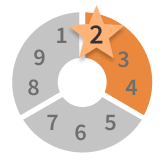

#2. The Collaborator
Type two is referred to as the Collaborator. The Collaborator is generous, nurturing, and highly attuned to the needs of others, but may struggle with setting boundaries and neglecting their own needs in favor of others.
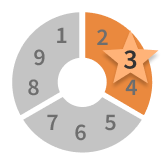

#3. The Dynamo
Type three is referred to as the Dynamo. The Dynamo is driven, ambitious, and highly focused on success and achieving their goals. Threes possess remarkable adaptability, adept at changing the presentation of who they are depending on who the are with. However, they might encounter challenges in embracing authenticity and vulnerability.
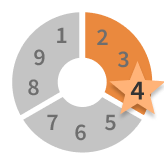

#4. The Maverick
Type four is referred to as the Maverick. They are known for being creative, introspective, and highly attuned to their emotions.
Fours often feel a sense of longing or incompleteness and may struggle with feelings of inadequacy and feeling like they are too different from others.
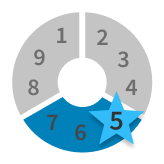

#5. The Philosopher
Type five is referred to as the Philosopher. The Philosopher is analytical, perceptive, and highly focused on knowledge and understanding. Fives are highly independent and may struggle with socializing and emotional expression.
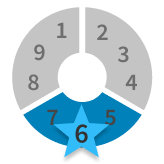
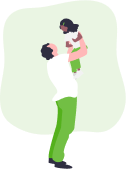
#6. The Allegiant
Type six is referred to as the Allegiant. The Allegiant is loyal, responsible, and highly attuned to potential dangers and threats, but may struggle with anxiety and self-doubt.
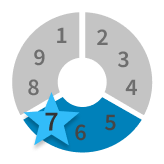

#7. The Aficionado
Type seven is referred to as the Aficionado. The Aficionado is spontaneous, optimistic, and highly focused on experiencing pleasure and avoiding pain.
Sevens may struggle with boredom and lack of focus and often seek out new experiences and adventures.
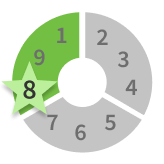

#8. The Contender
Type eight is referred to as the Contender. The Contender is powerful, assertive, and highly attuned to issues of fairness and justice.
Eights may struggle with control and vulnerability and often seek to protect themselves and those they care about.
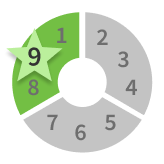

#9. The Harmonizer
Type nine is referred to as the Harmonizer. The Harmonizer is easy-going, accommodating, and highly attuned to the needs of others. Nines may struggle with conflict and assertiveness and often seek to maintain harmony and peace in their relationships and environments.
What are The Lines Connecting The Core Types?
Example Enneagram Result
The two arrows, or lines, connecting the primary core type to two other core types indicate the directions of growth and stress, commonly referred to as the "arrows of integration" and the "arrows of disintegration." Integration may also be called "The Rise", "Strong Bounds", or "Growers". Disintegration may also be called "The Fall", "Weak Bounds", or "Stressors".
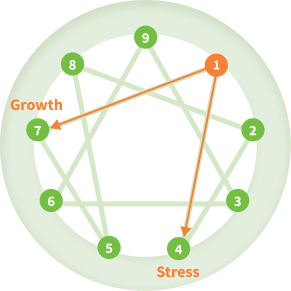
What does the Rise and Fall mean? - During times of extreme strength (growth) and weakness (stress), we often show different aspects of our personality. A strong bound signifies traits expressed during times of strength or growth, while a weak bound signifies traits expressed during times of weakness or stress.
Understanding these can help individuals identify their natural tendencies and how to respond when they are in a healthy state and their potential challenges when they are under stress. By using this information, individuals can develop strategies for personal growth and self-improvement.
Rise (Times of Strength)
This arrow or line connects the primary core type to another core type and shows the path of growth or integration. When individuals are in a positive or healthy state, they can exhibit characteristics of the core type the arrow is pointing to.
This serves as an indicator of behaviors or tendencies that may come about when you are not in a balanced or healthy state. It can provide insights into potential pitfalls or defense mechanisms to be aware of.
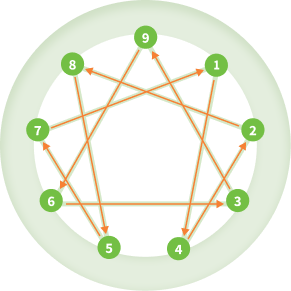
For example, if your core type is Type 4 and your fall (disintegration type) is Type 2, you might recognize that under stress, you may exhibit tendencies of seeking validation or becoming overly dependent on others. By acknowledging this, you can work on maintaining healthy boundaries, practicing self-care, and finding ways to meet your own needs during challenging times.
Applying the Enneagram Results
After receiving your results, it's time to focus on what it all means in relation to your life. After all, just taking an assessment is useless and will not improve your life unless you learn how to apply it toward understanding yourself and others better.
Self-Discovery
Self-discovery through the Enneagram involves reflecting on our motivations, fears, desires, and behavior patterns. Identifying strengths, weaknesses, and tendencies can allow for a deeper understanding of the self.
Relationship Building
The Enneagram claims to help us recognize and understand our own patterns of behavior and communication, as well as those of our partner, friend, or family member. This knowledge can then be used to cultivate healthier and more fulfilling relationships, both personally and professionally.
Career Guidance
The Enneagram can be a helpful career guidance tool by providing insights into our strengths, weaknesses, and motivations. The test claims to identify the types of work and environments that are most fulfilling and rewarding for us, as well as jobs that may be challenging or draining.
There are many Enneagram tests available online, and some are more legitimate than others. Make sure the Enneagram test you choose has been certified and/or the work established from validated research.
We approve: Enneagram Assessment by Personality Path

Be cautious of the websites associating with psychologists or doctors that are only paid advocates and not a part of the research and development.
When looking for a reliable Enneagram test, look for tests created by experienced Enneagram practitioners or researchers and have been tested for both reliability and validity. Additionally, it's a good idea to choose a test that provides comprehensive feedback and interpretation of the results rather than just a simple type designation.
Comparing Enneagram to CareerFitter
Although the Enneagram may be able to offer some insights and serve as a potent instrument for self-exploration and individual development, it should be noted that it does not encompass the entirety of career guidance nor provide definitive answers in that path.
Work personality assessments, such as CareerFitter, have been beneficial in providing insights into personality strengths and preferences in the workplace by specifically assessing a person's work personality and further refining the results with additional assessments of a person's aptitude and aversions. Career assessments can help us identify the careers that are the best match, types of tasks, work environments, and roles most suited to our personality.

By identifying your work personality strengths, CareerFitter provides detailed guidance on the types of tasks, work environments, and roles most suited to your personality when you are working.
Additionally, CareerFitter is the only career test to combine a work personality test with an assessment of your aptitudes and aversion to work environments, further guiding your list of careers that are best suited for your satisfaction, energy, productivity, and success.
The combination of a work personality assessment, an aptitude test, and an aversion assessment creates the most comprehensive and personalized approach to career planning and decision-making.
In the traditional Enneagram system, Type 9 is typically associated with having Type 8 and Type 1 as its wings. However, note the Enneagram is a changing and evolving system, and different interpretations and variations exist.
While the traditional understanding suggests Type 8 and Type 1 as the wings for Type 9, some alternative interpretations and schools of thought propose that other adjacent types can also serve as wings. This can include Type 6 and Type 3 as wings for Type 9.







